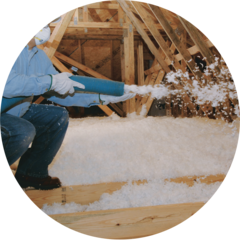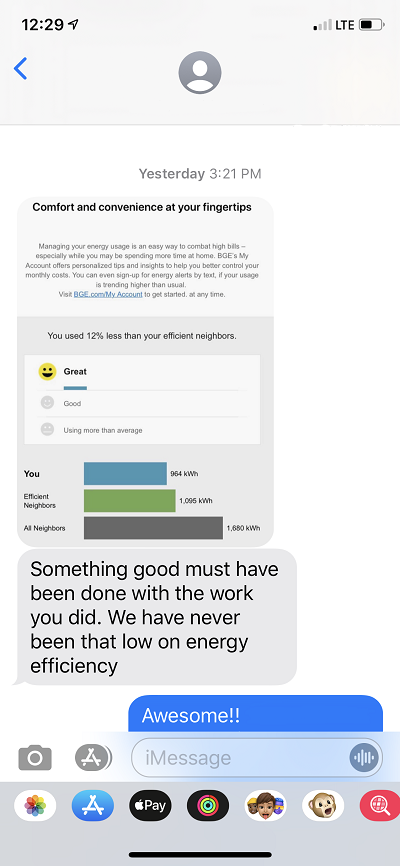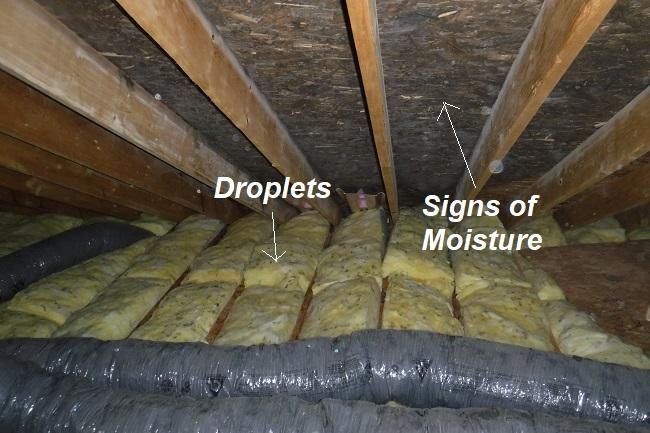How do I Know this Stuff?
If you are interested in figuring out how much attic insulation costs, there might not be any better way than to look at a project than through the eyes of a certified home energy auditor - such as myself.
I set out into Maryland communities every day to perform comprehensive home energy audits for BGE and Pepco utility energy customers by inspecting their attics, crawl spaces, and basements and then providing them with solutions, insulation costs, and returns on their potential investments.
Each home energy audit requires that a specific set of data points for the house get collected. During that process, it is an auditor's job to determine what "opportunities" exist for low-cost insulation improvements, also known as retrofits.
Retrofitting is the work that goes into Home Performance.
You will find loose fill insulation, spray foam in different varieties, fiberglass insulation, rigid foam board, caulk, baffles and attic domes if you visited a home performance project while in progress.
Making a real impact on your comfort and overall energy efficiency is the goal of the comprehensive home energy assessment and the subsequent retrofitting.
Home Performance vs. Attic Insulation
In addition to the bottom line cost of attic insulation, another thing you must consider is the two different ways you can go about getting insulation pricing and how they differ. You don't want to miss key techniques that make a big difference in your final results.
1. Typical Insulation Quote
Most people tend to get an insulation cost estimate the familiar way which is to call ABC Insulation Company and have a rep come out, take a look in the attic, and give them a price.
After all, it is only insulation and it is in the attic. How hard can it really be?
2. Home Performance: Comprehensive Energy Audit
An energy audit has a primary goal: to evaluate your home as a complete system and report back to you. The energy audit is actually an assessment and it uses a whole-house approach to calculate energy usage deficiencies and find ways to make everything work much, much better. And, it comes with measurable results.
Much like the performance of your car increases with a tune-up, your home can perform better after tightening things up! This means that you are able to sit in the driver's seat when it comes to creating better comfort and efficiency.
Another key benefit of getting the audit done is knowing that all of the possible insulation costs will be uncovered in advance for accurate pricing and budgeting. -Top-
Think About Home Insulation in Three-Dimensional Ways
Common Insulation Misperceptions
Most homeowners think that the more insulation you have the more efficient you are and the more comfortable you will be.
Others believe that insulation is missing in their walls and it is the reason why bills are high and comfort is low.
But, if you miss the opportunity to insulate your home correctly, then it could leave you scratching your head about why it is not more comfortable in the house and why the energy bill has not gone down.
What does it mean to insulate effectively?
Establish a Pressure & Thermal Boundary
If you have had a typical insulation quote recently and the representative did not mention the pressure and thermal boundary then you might be on a path to an incorrectly installed insulation project.
Most insulation, alone, will not stop the flow of air.
Insulation is similar to a jacket. If a jacket is not zipped, the air flows inside and around the shell resulting in loss of body heat and comfort woes.
If insulation (thermal boundary) has nothing stopping the flow of air (pressure boundary), then your home loses energy and you feel drafts.
Building Envelope
Identifying your house's envelope or "shell" is important for a properly estimated and installed insulation project.
Knowing where insulation is needed at every turn and what type of insulation is best for the job is an energy auditor's assignment.
Pressure dynamics inside your house create infiltration (air coming in) and exfiltration (air going out) in places that will get missed if building science principles are not applied during a typical insulation quote.
Incorrect Diagnosis
A typical insulation quote may provide information about insulation for walls which is costly and will undoubtedly yield little to no meaningful results.
An energy audit is a great way to gain a new perspective on how your home is actually losing energy and why the top and bottom are way more important than the sides.
Testing
Did you know that a properly installed insulation project around the house is likely to yield measurable results compared to window and door projects that tend to cost more?
For starters, an energy audit will perform an air leakage test (blower door test) and each window and door can be checked.
The blower door test is not something you would get with a typical insulation quote.
The test can show how ceilings, walls, floors, and basement areas all lead to as much as 40% of a home's air leakage compared to only 10% for windows and doors. -Top-
The Attic Insulation Technician - Required Skills
Determining how much attic insulation costs also will depend on the solution's complexity. Each home is quite different and getting measurable results requires hiring skilled technicians that are properly trained on how to do the job right.
Sealing and insulating a building shell requires technicians to work in tight spaces. Crews must be in good physical condition.
Watch this skilled technician install a baffle at the attic low point.
Often times similar houses in the same development have different problems. Through the years, different owners make changes to the building shell. Each property owner had their own "vision" along the way.
X-Ray Vision
For the best results, technicians must have good general knowledge of residential building construction, including basic knowledge about the techniques that are used when building additions.
The insulation crew needs to be able to look past the boundaries that the eye can see so that sealing the right spots or not sealing the right spots is constantly being considered.
Otherwise, important measures required to make the job effective, may not get completed.
The quality of the workmanship should and does factor into the cost of an attic insulation job. -Top-
Proper Measurements Are Key to Attic Insulation Cost
Houses that need pricing for attic insulation usually have lots of twists and turns. This is not because the insulation is different or because the house is older, rather it is a simple fact that all houses are complicated.
Knowing how to evaluate things from all six sides when determining the proper treatment is key to accurate insulation pricing.
Missing a measurement or a location where insulation is required could be the difference between not only an accurately priced job but also a job that will yield the desired results.
Similarly, if you don't seal all of the holes in a leaky boat then you might as well not seal any cause you're still gonna sink!
A detailed work scope should be provided with specific information about the area/measurements and treatment methods. -Top-
The Size and Style of Home Impacts Insulation Cost
In all cases, insulation around a home must be contiguous with an air barrier. That is that the insulation and the air barrier must be together wherever the boundary between inside and outside exists.
When considering how much attic insulation costs, it should be understood that the price depends on the style and size of the home.
If a home has high ceilings in a bedroom and a standard ceiling in the hallway, there could be higher costs. This configuration creates a knee wall that also needs insulation.
If a house has a crawl space foundation and also has high ceilings on the upper floors, then the cost will be higher than a home that does not have those features.
A good general way to figure out the cost comparison of two insulation jobs is to determine the overall square footage of the home's envelope or building shell.-Top-
What are the Costs of Having Existing Insulation Removed?
 In most home renovation projects it is customary to get rid of the old. For example, during a replacement roofing project, the old shingles are stripped off the roof and thrown into a dumpster not to be used again. The old shingles have no value. In fact, adding shingles over top of old shingles will actually lower the value of the project and the overall value of the home.
In most home renovation projects it is customary to get rid of the old. For example, during a replacement roofing project, the old shingles are stripped off the roof and thrown into a dumpster not to be used again. The old shingles have no value. In fact, adding shingles over top of old shingles will actually lower the value of the project and the overall value of the home.
Insulation, on the other hand, is different. The insulation in your attic, believe it or not, does have some value. For example, if you have 10 inches of fiberglass rolled batting insulation on your attic floor, the R-Value is calculated at 10 inches by a factor of 2.1 to get the R-Value of the material. So, in essence, the insulation is giving you back some insulating qualities.
Unfortunately, as in the scenario above, there is typically not enough insulation to adequately separate the living space from the outside. But, there is no reason to get rid of the value that you do have. For example, if the R-Value of your existing insulation is calculated at R-20 and the recommended value should be R-49, then you only need R-29 to get where you need to be.
Removing existing insulation actually gets you further away from the mark you need to hit and will end up costing you more.
Here is one key thing to always remember: there is virtually no reason to remove existing insulation on the attic floor. Insulation is on the "outside" of your home.
Insulation that has been subjected to mold growth will not be a threat to your health if the issue causing the mold growth is stopped. Therefore, throwing away insulation that has mold on it once the problem is resolved is a waste of resources.
Once you stop a moisture issue in an attic that is leading to mold, it is not necessary to remove the dirty insulation.-Top-
Solutions: Insulation Cost Analysis
**Pricing listed in this article is based on information gathered in the Maryland market.
There is an expression in team sports like football and basketball. It goes something like this: "Let's take what the defense is giving us". Essentially, what the team is saying is let's go after the places that the other team is not guarding. The path of least resistance, so to speak.
In preexisting homes, it is a similar game plan. We have to "take what the house is giving us". This means that careful consideration should be given to treating the areas that are accessible compared to the areas that cannot be reached. This approach will have a significant impact on the overall cost.
As a general rule, when you are dealing with a Home Performance contractor, the overall goal is to find the opportunities that:
SAVE YOU THE MOST and COST YOU THE LEAST!
Watch to Get More Insight Into Attic Issues
-Top-
Insulation Costs
Let's take a look at what items are on the retrofit list and figure out a little more about each type of project including what is involved with treatment and how much each insulation solution costs.
Cost for Rim Joist Air Sealing & Insulation
$5.25 per linear foot
Air Seal and Insulate Rim Joist - The cost of an attic insulation job should also include easy-to-access areas in the basement or at the foundation area. Great opportunities to seal the basement exist at the top of the foundation wall. Basement work in tandem with attic work will yield the best overall results.
-Top-
Watch before and after treatment to the basement rim and band joist.
Knee Walls Insulation Cost and Treatment Methods
$4.25 per square foot
General Knee Wall Insulation with Air Barrier - Generally, a knee wall is much like an exterior wall. The difference - it is accessible from an attic area. Knee walls are usually insulated, but not well, and as a result, they are major sources of energy loss and comfort complaints. To properly "button" up a knee wall, you can expect to pay for air sealing, new insulation, and some type of air barrier (sheathing).
$3.50 per linear foot
Block & Seal Knee Wall Attic Floor Gaps - A big issue that many homeowners don't address is the space between floors. The space between the floors is only accessible if certain types of residential home construction.
-Top-
Check out a knee wall issue and how it gets treated.
Attic Access Costs & Solution Types
From $175 up to $300 per opening
Most homes have at least one way to get to an attic space that needs to be sealed. The best way to determine how many hatches you have is to count. Then for each one, consider where you access the space. If you are inside, then you need to seal the opening to disconnect it from the attic. Attic access can range in price depending on the size, type, and location.
The most commonly seen attic access points are push-up hatches and pull-down stairs.
Watch a technician treat an attic hatch in the field.
Attic Air Sealing Costs
Air sealing an attic can be broken down into two main parts.
$1.00 per square foot
1. General Air Sealing: includes the top plates, standard penetrations (regular light fixtures, plumbing stacks, and general voids and cracks.
-Top-
Watch a technician air seal connections between the attic and inside.
From $50 - $200
2. Ala Carte Air Sealing:
A. Combustion appliance flues
B. HVAC chase openings
C. Staircase voids and other thermal bypasses that are created by the construction style of the home.
D. Vertical wall air sealing
E. Recessed Lights
F. Chimneys
G. Plumbing Penetrations
Cost per air sealing solution can range depending on the requirements to properly seal the area.
Attic Insulation Cost
A key to determining the cost of insulation for your home is to figure out what the current R-value is in the attic and around the shell of the home. You can use this article to determine your exact R-value and come back to see what the cost is per square foot for the R-value you are missing.
Insulation Price Matrix - Blown In Insulation Solution
$ Per Square Foot
R-13.......$.98
R-19.......$1.35
R-21.......$1.57
R-30......$2.07
R-38......$2.43
R-49.......$3.07
R-60.......$3.77
Watch loose fill insulation being installed.
Baffle Installation Pricing
$4.00 Each
Attic ventilation is important for the longevity of your roof, roof deck, insulation, and wood framing. You should expect that for every foot of eave, you have around your house that you will need 1/2 a baffle to improve, maintain or in some cases actually create new air intake for ventilation. Baffles are installed in the toughest-to-reach places in the attic - the lowest place the roof deck is in relation to the attic floor. -Top-

Baffles maintain a channel for air intake and good attic ventilation.
Cantilever (Overhang) Insulation Costs

Overhangs on the front and rear of your home are wonderful because they add valuable square footage to the inside of the living space it can really make a difference. The problem, they are susceptible to air infiltration if not insulated properly and they are hard to get to.
Pricing for a cantilever can vary depending on many challenges, including the height at which the cantilever is positioned, the type of siding, if any, is in place and the amount of insulation required to fill the cavity.
You can expect a cantilever project to cost between $275 - $2000 and more. Analysis should be given to the value vs. cost for a cantilever project. A well-trained energy auditor can give you guidance on this type of insulation solution and the cost.
Tip: Once you identify the location of any first-floor cantilever you have, take a look to see how that aligns with any unfinished portion of the basement. If the two areas match up then the overall cost can be less since the need to remove the soffit is not necessary.
Watch spray foam being applied to this overhang with ducts.
-Top-
Cost of Crawl Space Insulation/ Encapsulation
A crawl space foundation creates great opportunities for improved efficiency, comfort, and indoor air quality. On the other hand, it can escalate the overall cost of an insulation project.
Untreated crawl spaces tend to go unnoticed when homeowners are thinking about how much an attic insulation project costs, but not considering the space for treatment could be the difference between an attic insulation job that yields results and one that does not.

Crawl Space Before

Crawl Space After
Crawl spaces have to be broken down into the following components of the job:
Typical Crawl Space Work Scope and Insulation Cost
Removal of Existing Insulation - $2.00 per sq. ft.
Floor/Vapor Barrier - $1.50 per sq. ft.
Walls (R-13) - $6.00 per sq. ft.
Closed Cell Spray Foam - $12.00 per sq. ft. (includes ignition barrier)
Rim Joist $5.25 per linear foot
Duct Sealing $2.50 per linear foot
Any Access Points - $175 - $300 each
Dense Pack Insulation Cost and Solutions
Hometrust will recommend dense-pack insulation solutions for easily accessible cavities that can be properly "packed" to get the desired result. Dense packing walls are a project that should be given a lot of consideration by any homeowner in any age home.
Pitfalls associated with improper installation techniques could render the work useless, however, you may never really know.
The cost to dense pack a cavity is $6.00 per sq. ft.
To understand more about why sealing the top and bottom of a home are most beneficial, read this information about building science.
-Top-
________________

Written by Eric Gans
I have over 1000 energy audits under my belt in Maryland and each scenario requires an insulation cost analysis. I am certified through the Building Performance Institute.
I would like to hear your comments about this article. Feel free to post something below...







































